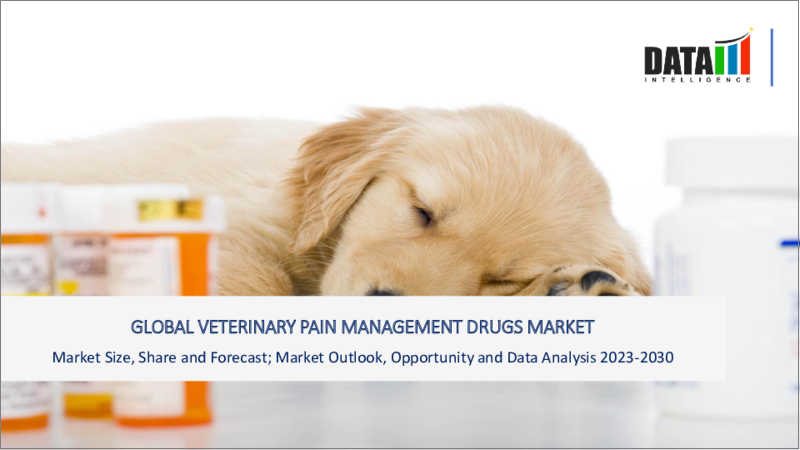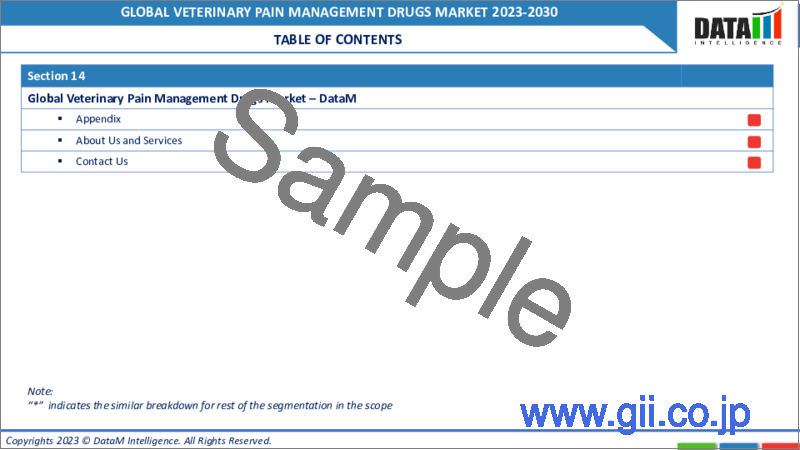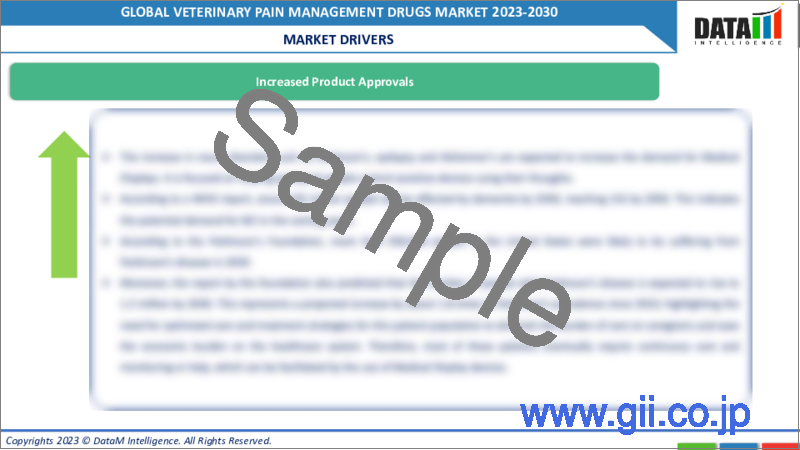|
|
市場調査レポート
商品コード
1166510
獣医用疼痛管理薬の世界市場-2022-2029Global Veterinary Pain Management Drugs Market - 2022-2029 |
||||||
|
● お客様のご希望に応じて、既存データの加工や未掲載情報(例:国別セグメント)の追加などの対応が可能です。 詳細はお問い合わせください。 |
|||||||
| 獣医用疼痛管理薬の世界市場-2022-2029 |
|
出版日: 2022年11月30日
発行: DataM Intelligence
ページ情報: 英文 180 Pages
納期: 約2営業日
|
- 全表示
- 概要
- 目次
市場の概要
獣医用疼痛管理薬の世界市場規模は、2021年に12億2,170万米ドルに達し、予測期間(2022-2029年)にはCAGR5.6%で成長すると予測されています。
獣医用疼痛管理薬とは、伴侶動物や畜産動物の変形性関節症、術後疼痛、がんなどの疾病の予防、診断、治療のための医療サービスのことを指します。
市場力学
世界の獣医用疼痛管理薬の市場成長は、動物における疼痛性疾患や炎症性疾患の有病率の上昇、動物ヘルスケアに向けた取り組みの増加、コンパニオンアニマル飼育数の増加といった特定の要因によって推進されています。
動物ヘルスケアに向けた政府の取り組みが増加していることから、予測期間中に世界の獣医用疼痛管理薬市場を牽引することが期待されます。
2019年11月、世界小動物獣医師会(WSAVA)の世界疼痛協議会(GPC)は、疼痛管理におけるキーオピニオンリーダー(KOL)、すなわち「先生」の世界ネットワークの構築を目指す「先生を教える」というプログラムを開始し、地域内で知識の伝播と普及に意欲的な活動を展開しています。
2020年3月、ケトフェン10%の製造元であるセバ・アニマルヘルスは、疼痛緩和が跛行牛に与えるポジティブな影響と、回復時間と成績の向上に果たす役割を強調する「Wave Goodbye to Pain」キャンペーンを開始しました。このキャンペーンは、NSAIDs(抗炎症・鎮痛剤)の注射を跛行の治療に効果的な削蹄やブロックと同時に行うと、相乗効果(単なる追加効果より大きい)があることを明らかにしたノッティンガム大学の研究結果を受けて開始されました。この発見は、過去10年間で酪農家が痛み止めの必要性をますます認識するようになり、52%が追加費用を支払って喜んでいる(2006年の36%から上昇)という2番目の研究結果とともに発表されました。
流通経路の変化が市場成長の妨げになる可能性が高い
一般的に、コンパニオンアニマルの飼い主は、動物用医薬品を獣医師から直接購入しています。コンパニオンアニマルの飼い主は、その購入パターンを変え、インターネットベースの小売業者、小売店、その他の店頭販売チャネルに重点を移すようになりました。このような変化は、動物用医薬品の代わりにヒト用医薬品がより低価格であると判断された場合、動物用医薬品の代わりにヒト用医薬品を選択するコンパニオンヘルス所有者につながっています。
さらに、獣医師のような主要顧客の統合は、コンパニオンヘルスケア製品の価格に悪影響を及ぼす可能性があります。さらに、低価格の後発品とその使用量の増加は、市場の可能性を阻害する可能性があります。規制機関による規制は、疼痛緩和薬の売上に悪影響を及ぼす可能性があります。コンパニオンヘルスケアのコスト増と動物実験に関する規制の強化は、さらに市場の妨げになる可能性があります。
さらに、輸送網の不備、冷蔵施設の不足、健康診断のための検査機関ネットワークの不足などにより、医薬品やワクチンを必要な場所に輸送することが困難になる可能性もあります。購入パターンの変化、ジェネリック医薬品の増加、低価格のヒト用医薬品サブリミテッド、規制による制限などは、市場の成長を大きく抑制する可能性がある主要な要因です。
COVID-19の影響分析
COVID-19の発生は、動物用鎮痛剤を含むすべての世界産業に影響を及ぼしています。ペットの親は、衛生状態を維持し、汚染のリスクを減らすために、ペットから安全な距離を保つことを勧められています。さらに、畜産分野にも影響が及んでいます。肉、牛乳、卵などの畜産物の市場への移動が困難になっています。反芻動物との季節的な国境越えで制限が実施されています。例えば、2020年4月、食糧農業機関は、COVID-19パンデミック時の家畜生産と畜産物のサプライチェーンに関する新しい方針を発表しました。
目次
第1章 調査手法と調査範囲
- 調査手法
- 調査目的と調査範囲
第2章 市場の定義と概要
第3章 エグゼクティブサマリー
- 薬物別市場内訳
- 投与経路別市場内訳
- 動物別市場内訳
- 用途別市場内訳
- 流通チャネル別市場内訳
- 地域別市場内訳
第4章 市場力学
- 市場影響要因
- 促進要因
- 動物における疼痛性疾患および炎症性疾患の有病率の上昇
- 動物ヘルスケアに向けた取り組みの増加
- コンパニオンアニマルの飼育数の増加
- 抑制要因
- 薬剤に伴う副作用
- 流通経路の変化
- ビジネスチャンス
- 影響分析
第5章 産業分析
- ポーターのファイブフォース分析
- サプライチェーン分析
- 法規制分析
- 価格設定分析
第6章 COVID-19の分析
- COVID-19の市場分析
- COVID-19以前の市場シナリオ
- COVID-19の現在の市場シナリオ
- COVID-19の後、または将来のシナリオ
- COVID-19の中での価格ダイナミクス
- 需要-供給スペクトラム
- パンデミック時の市場に関連する政府の取り組み
- メーカーの戦略的な取り組み
- まとめ
第7章 薬剤タイプ別
- 非ステロイド性抗炎症薬
- メロキシカム
- デラコキシブ
- カルプロフェン
- エトドラク
- フィロコキシブ
- その他
- オピオイド
- モルヒネ
- コデイン
- フェンタニル
- ブプレノルフィン
- その他
- 局所麻酔薬
- リドカイン
- ブピバカイン
- メピバカイン
- その他
- α2アゴニスト
- メデトミジン
- キシラジン
- ロミフィジン
- その他
- 疾患修飾性骨関節炎治療剤(DMOAD)
- その他
第8章 投与経路別
- 経口
- 非経口
- 局所投与
第9章 動物別
- コンパニオンアニマル
- 犬
- 猫
- 馬
- その他の動物(コンパニオンアニマル)
- 家畜
- 牛
- 豚
- その他の畜産物
第10章 用途別
- 術後疼痛
- 関節痛
- 変形性関節症
- 筋骨格系疾患
- がん
- その他
第11章 流通チャネル別
- 動物病院・クリニック
- 小売薬局
- オンライン薬局
第12章 地域別
- 北米
- 米国
- カナダ
- メキシコ
- 欧州
- ドイツ
- 英国
- フランス
- イタリア
- スペイン
- その他欧州
- 南米
- ブラジル
- アルゼンチン
- その他の南米地域
- アジア太平洋地域
- 中国
- インド
- 日本
- オーストラリア
- その他アジア太平洋地域
- 中東とアフリカ
第13章 競合情勢
- 競合シナリオ
- メーカーが採用した主な戦略
- 市況分析/シェア分析
- 製品ベンチマーク
第14章 企業プロファイル
- Dechra Pharmaceuticals
- 企業概要
- プロシージャーのポートフォリオと説明
- 主なハイライト
- 財務概要
- Zoetis
- Elanco
- Boehringer Ingelheim
- Vetoquinol S.A.
- Ceva Sante Animale S.A.
- Bayer AG
- Merck Animal Health
- Norbrook Laboratories
- Chanelle Pharma
- Virbac
- Assisi Animal Health
第15章 データム
Market Overview
The global veterinary pain management drugs market size was valued at US$ 1221.7 million in 2021 and is estimated to reach US$ XX million by 2029, growing at a CAGR of 5.6% during the forecast period (2022-2029).
Veterinary Pain Management Drugs refers to the medical services for the prevention, diagnosis, and treatment of diseases like Osteoarthritis, Postoperative pain, and Cancer in companion and livestock animals.
Market Dynamics
The global veterinary pain management drugs market growth is driven by the certain factors such as the rising prevalence of painful and inflammatory diseases in animals, increasing initiatives towards animal healthcare and increasing number of companion animal ownership.
The increasing government initiative towards animal healthcare, is expected to drive the global veterinary pain management drugs market during the forecast period
In November 2019, the Global Pain Council (GPC) of the World Small Animal Veterinary Association (WSAVA) has launched a program called 'Teach the Teachers,' which aims to create a global network of key opinion leaders (KOLs) - 'teachers' - in pain management, who are motivated to propagate and disseminate their knowledge within their regions.
In March 2020, Ceva Animal Health, the manufacturer of Ketofen 10%, has launched a 'Wave Goodbye to Pain' campaign to highlight the positive impact of pain relief on lame cattle and the role it can play in improving recovery time and results. The initiative was launched following a study by Nottingham University which revealed that NSAIDs (anti-inflammatory and pain-relieving injections) have a synergistic (greater than simply additive) effect when given alongside effective hoof trimming and blocking to treat lameness. The findings have emerged alongside a second study showing that over the last 10 years, farmers are increasingly aware of the need for pain relief and 52% are happy to pay the extra costs involved (up from 36% in 2006).
Changes in distribution channel are likely to hinder the market growth
Generally, companion animal owners purchase their animal health products directly from veterinarians. Companion animal owners has changed their purchase pattern and shifted the focus towards internet-based retailers, retail stores, or other over-the-counter distribution channels. This shift is leading the companion health owners to opt for substitute human health products for animal health products if human health products are deemed to be lower-cost alternatives.
Moreover, consolidation of primary customers such as veterinarians might adversely affect price of companion healthcare products. Further, low-cost generic product subtitles and their increased usage might hamper the market potential. Restrictions by regulatory bodies might have a negative impact on the sales of pain relief drugs. Increasing costs of companion healthcare and increasing regulations on animal testing might further hamper the market.
Moreover, lack of infrastructure may also make it difficult to transport medicines and vaccines to where they are required because of poor transport links, lack of refrigeration, and networks of laboratories for conducting health tests. Change in purchase patterns, increased generic drugs, low-cost human drug sublimities, and regulatory restriction are key factors which might restrain the market growth significantly.
COVID-19 Impact Analysis
The COVID-19 outbreak has impacted all global industries, including veterinary pain medicine. Pet parents are advised to keep a safe distance from their pets to maintain hygiene and reduce the risk of contamination. Moreover, the impact has been seen in the livestock sector. Moving animal products, such as meat, milk, and eggs, has been trouble moving to markets. The restriction has been implemented on the seasonal border crossing with ruminants. For example, in April 2020, the Food Agriculture Organization published a new policy regarding the production of livestock and the supply chain of livestock products during the COVID-19 pandemic.
Segment Analysis
The non-steroidal anti-inflammatory drugs (NSAIDs) segment is expected to grow at the fastest CAGR during the forecast period (2022-2029)
Non-steroidal anti-inflammatory drugs are one of the most commonly used and most effective drug in the treatment of pain due to arthritis or after surgery in dogs and cats. Rimadyl, Metacam, Dermaxx, Etogesic, among others comes under this class of drugs. NSAIDS act by inhibiting inflammatory substances called prostaglandins (PGEs), which cause pain, inflammation, and fever. Hence they are called 'anti-inflammatory' but their main purpose is pain control (inflammation is how pain starts). These drugs are readily available, relatively long-acting, and generally inexpensive. They can also be given at home after an animal has been released from the hospital. For these reasons, they have long been used for pain relief. Veterinarians may prescribe NSAIDs as one part of the total plan for pain relief, provided the animal does not have kidney, liver, blood clotting, or stomach problems.
However, some side effects can occur, with the most common being gastrointestinal (GI) disturbance (symptoms include vomiting, diarrhea, bloody or dark colored feces) from minor GI-ulcers. There is also risk of acute liver and/or kidney failure with all NSAIDs.
Geographical Analysis
North America region holds the largest market share of the global veterinary pain management drugs market
North America accounted for the largest share of the veterinary pain management market. Rise in the number of veterinarians across the world is believed spearhead current and future market growth of veterinary pain management drugs during the forecast period. For instance, according to the 2019-2020 National Pet Owners Survey, conducted by the American Pet Products Association (APPA), around 67% of the country's households, or about 84.9 million families, own a pet. In addition, highly developed and well-established animal healthcare facilities is further fueling the growth.
Rising collective efforts by key players to improve their product portfolio and to ensure high-quality standards are projected to boost the regional demand. For instance, in May 2017, Norbrook launched chewable Carprieve tablets for dogs in a probe to expand its product portfolio.
In 2020, the United States Food & Drug Administration approved Cronus Pharma Specialties' Carprofen Chewable Tablets (generic version of Rimadyl-Zoetis) for dogs. This nonsteroidal anti-inflammatory drug (NSAID) has been proven safe and effective in relieving pain and inflammation associated with osteoarthritis. Also, it helps control postoperative pain associated with soft tissue and orthopedic surgeries.
Competitive Landscape
The veterinary pain management drugs market is highly competitive and consists of a large number of players.
Some of the major players in the global veterinary pain management drugs market are Dechra Pharmaceuticals, Zoetis, Elanco, Boehringer Ingelheim, Vetoquinol S.A., Ceva Sante Animale S.A., Bayer AG, Merck Animal Health, Norbrook Laboratories, Chanelle Pharma, Virbac, among others. The key players are adopting strategies such as mergers and acquisitions, partnerships, and regional expansion to stand out as strong competitors in the market. New product launches along with increased focus on R&D are other ways the leading players improve their market presence.
For instance, In April 2020, The UK Competition and Markets Authority or CMA Monday has launched a merger inquiry into Dechra Pharmaceuticals PLC's (DPH.L) anticipated acquisition of the Osurnia business of Elanco Animal Health Inc. (ELAN).
Key Companies to Watch
Zoetis Inc
Overview: Zoetis Inc. is a U.S. based animal health company involved in the production of medicine, vaccines, diagnostic products and other veterinary solutions. The company is considered as the global leader in veterinary vaccines market. The company is operating under three reportable segments - Livestock, Companion Animal and Contract manufacturing & human health. Zoetis's Livestock business is responsible for the development, production and distribution of vaccines, anti-infective, paraciticides and medicated feed additives.
Product Portfolio: SIMBADOL (buprenorphine injection) offers continuous 24-hour surgical pain control for cats - even through the night.
The global veterinary pain management drugs market report would provide an access to an approx. 40+ market data table, 45+ figures and 180 pages.
Table of Contents
1. Methodology and Scope
- 1.1. Research methodology
- 1.2. Research Objective and Scope of the Report
2. Market Definition and Overview
3. Executive Summary
- 3.1. Market Snippet by Drugs
- 3.2. Market Snippet by Route of Administration
- 3.3. Market Snippet by Animal
- 3.4. Market Snippet by Application
- 3.5. Market Snippet by Distribution Channel
- 3.6. Market Snippet by Region
4. Market Dynamics
- 4.1. Market Impacting Factors
- 4.2. Drivers
- 4.2.1. Rising Prevalence of Painful and Inflammatory Diseases in Animals
- 4.2.2. Increasing Initiatives towards Animal Healthcare
- 4.2.3. Increasing number of companion animal ownership
- 4.3. Restraints
- 4.3.1. Side Effects Associated with Drugs
- 4.3.2. Changes in Distribution Channel
- 4.4. Opportunity
- 4.5. Impact Analysis
5. Industry Analysis
- 5.1. Porter's Five Forces Analysis
- 5.2. Supply Chain Analysis
- 5.3. Regulatory Analysis
- 5.4. Pricing Analysis
6. COVID-19 Analysis
- 6.1. Analysis of Covid-19 on the Market
- 6.1.1. Before COVID-19 Market Scenario
- 6.1.2. Present COVID-19 Market Scenario
- 6.1.3. After COVID-19 or Future Scenario
- 6.2. Pricing Dynamics Amid Covid-19
- 6.3. Demand-Supply Spectrum
- 6.4. Government Initiatives Related to the Market During Pandemic
- 6.5. Manufacturers Strategic Initiatives
- 6.6. Conclusion
7. By Drug Type
- 7.1. Introduction
- 7.1.1. Market Size Analysis, and Y-o-Y Growth Analysis (%), By Drug Type Segment
- 7.1.2. Market Attractiveness Index, By Drug Type Segment
- 7.2. NSAIDS*
- 7.2.1. Introduction
- 7.2.2. Market Size Analysis, Y-o-Y Growth Analysis (%)
- 7.2.3. Meloxicam
- 7.2.4. Deracoxib
- 7.2.5. Carprofen
- 7.2.6. Etodolac
- 7.2.7. Firocoxib
- 7.2.8. Others
- 7.3. Opioids
- 7.3.1. Morphine
- 7.3.2. Codeine
- 7.3.3. Fentanyl
- 7.3.4. Buprenorphine
- 7.3.5. Others
- 7.4. Local Anesthetics
- 7.4.1. Lidocaine
- 7.4.2. Bupivacaine
- 7.4.3. Mepivacaine
- 7.4.4. Others
- 7.5. Alpha-2 Agonists
- 7.5.1. Medetomidine
- 7.5.2. Xylazine
- 7.5.3. Romifidine
- 7.5.4. Others
- 7.6. Disease Modified Osteoarthritis Drugs (DMOAD)
- 7.6.1. Others
8. By Route of Administration
- 8.1. Introduction
- 8.1.1. Market Size Analysis, and Y-o-Y Growth Analysis (%), By Route of Administration Segment
- 8.1.2. Market Attractiveness Index, By Route of Administration Segment
- 8.2. Oral*
- 8.2.1. Introduction
- 8.2.2. Market Size Analysis, Y-o-Y Growth Analysis (%)
- 8.3. Parenteral
- 8.4. Topical
9. By Animal
- 9.1. Introduction
- 9.1.1. Market Size Analysis, and Y-o-Y Growth Analysis (%), By Animal Segment
- 9.1.2. Market Attractiveness Index, By Animal Segment
- 9.2. Companion Animal*
- 9.2.1. Introduction
- 9.2.2. Market Size Analysis, Y-o-Y Growth Analysis (%)
- 9.2.3. Dogs
- 9.2.4. Cats
- 9.2.5. Horses
- 9.2.6. Other Companion Animals
- 9.3. Livestock
- 9.3.1. Cattle
- 9.3.2. Swine
- 9.3.3. Other Livestock Animals
10. By Application
- 10.1. Introduction
- 10.1.1. Market Size Analysis, and Y-o-Y Growth Analysis (%), By Application Segment
- 10.1.2. Market Attractiveness Index, By Application Segment
- 10.2. Postoperative Pain*
- 10.2.1. Introduction
- 10.2.2. Market Size Analysis, Y-o-Y Growth Analysis (%)
- 10.3. Joint Pain
- 10.3.1. Osteoarthritis
- 10.3.2. Musculoskeletal Disorders
- 10.4. Cancer
- 10.5. Other
11. By Distribution Channel
- 11.1. Introduction
- 11.1.1. Market Size Analysis, and Y-o-Y Growth Analysis (%), By Distribution Channel Segment
- 11.1.2. Market Attractiveness Index, By Distribution Channel Segment
- 11.2. Veterinary Hospitals & Clinics*
- 11.2.1. Introduction
- 11.2.2. Market Size Analysis, Y-o-Y Growth Analysis (%)
- 11.3. Retail Pharmacies
- 11.4. Online Pharmacies
12. By Region
- 12.1. Introduction
- 12.1.1. Market Size Analysis, and Y-o-Y Growth Analysis (%), By Region
- 12.1.2. Market Attractiveness Index, By Region
- 12.2. North America
- 12.2.1. Introduction
- 12.2.2. Key Region-Specific Dynamics
- 12.2.3. Market Size Analysis, and Y-o-Y Growth Analysis (%), By Drug Type
- 12.2.4. Market Size Analysis, and Y-o-Y Growth Analysis (%), By Animal
- 12.2.5. Market Size Analysis, and Y-o-Y Growth Analysis (%), By Route of Administration
- 12.2.6. Market Size Analysis, and Y-o-Y Growth Analysis (%), By Application
- 12.2.7. Market Size Analysis, and Y-o-Y Growth Analysis (%), By Distribution Channel
- 12.2.8. Market Size Analysis, and Y-o-Y Growth Analysis (%), By Countries
- 12.2.8.1. U.S.
- 12.2.8.2. Canada
- 12.2.8.3. Mexico
- 12.3. Europe
- 12.3.1. Introduction
- 12.3.2. Key Region-Specific Dynamics
- 12.3.3. Market Size Analysis, and Y-o-Y Growth Analysis (%), By Drug Type
- 12.3.4. Market Size Analysis, and Y-o-Y Growth Analysis (%), By Animal
- 12.3.5. Market Size Analysis, and Y-o-Y Growth Analysis (%), By Route of Administration
- 12.3.6. Market Size Analysis, and Y-o-Y Growth Analysis (%), By Application
- 12.3.7. Market Size Analysis, and Y-o-Y Growth Analysis (%), By Distribution Channel
- 12.3.8. Market Size Analysis, and Y-o-Y Growth Analysis (%), By Countries
- 12.3.8.1. Germany
- 12.3.8.2. U.K.
- 12.3.8.3. France
- 12.3.8.4. Italy
- 12.3.8.5. Spain
- 12.3.8.6. Rest of Europe
- 12.4. South America
- 12.4.1. Introduction
- 12.4.2. Key Region-Specific Dynamics
- 12.4.3. Market Size Analysis, and Y-o-Y Growth Analysis (%), By Drug Type
- 12.4.4. Market Size Analysis, and Y-o-Y Growth Analysis (%), By Animal
- 12.4.5. Market Size Analysis, and Y-o-Y Growth Analysis (%), By Route of Administration
- 12.4.6. Market Size Analysis, and Y-o-Y Growth Analysis (%), By Application
- 12.4.7. Market Size Analysis, and Y-o-Y Growth Analysis (%), By Distribution Channel
- 12.4.8. Market Size Analysis, and Y-o-Y Growth Analysis (%), By Countries
- 12.4.8.1. Brazil
- 12.4.8.2. Argentina
- 12.4.8.3. Rest of South America
- 12.5. Asia Pacific
- 12.5.1. Introduction
- 12.5.2. Key Region-Specific Dynamics
- 12.5.3. Market Size Analysis, and Y-o-Y Growth Analysis (%), By Drug Type
- 12.5.4. Market Size Analysis, and Y-o-Y Growth Analysis (%), By Animal
- 12.5.5. Market Size Analysis, and Y-o-Y Growth Analysis (%), By Route of Administration
- 12.5.6. Market Size Analysis, and Y-o-Y Growth Analysis (%), By Application
- 12.5.7. Market Size Analysis, and Y-o-Y Growth Analysis (%), By Distribution Channel
- 12.5.8. Market Size Analysis, and Y-o-Y Growth Analysis (%), By Countries
- 12.5.8.1. China
- 12.5.8.2. India
- 12.5.8.3. Japan
- 12.5.8.4. Australia
- 12.5.8.5. Rest of Asia Pacific
- 12.6. The Middle East and Africa
- 12.6.1. Introduction
- 12.6.2. Key Region-Specific Dynamics
- 12.6.3. Market Size Analysis, and Y-o-Y Growth Analysis (%), By Drug Type
- 12.6.4. Market Size Analysis, and Y-o-Y Growth Analysis (%), By Animal
- 12.6.5. Market Size Analysis, and Y-o-Y Growth Analysis (%), By Route of Administration
- 12.6.6. Market Size Analysis, and Y-o-Y Growth Analysis (%), By Application
- 12.6.7. Market Size Analysis, and Y-o-Y Growth Analysis (%), By Distribution Channel
13. Competitive Landscape
- 13.1. Competitive Scenario
- 13.2. Key Strategies adopted by Manufacturers
- 13.3. Market Positioning/Share Analysis
- 13.4. Product Benchmarking
14. Company Profiles
- 14.1. Dechra Pharmaceuticals*
- 14.1.1. Company overview
- 14.1.2. Procedure portfolio and description
- 14.1.3. Key highlights
- 14.1.4. Financial overview
- 14.2. Zoetis
- 14.3. Elanco
- 14.4. Boehringer Ingelheim
- 14.5. Vetoquinol S.A.
- 14.6. Ceva Sante Animale S.A.
- 14.7. Bayer AG
- 14.8. Merck Animal Health
- 14.9. Norbrook Laboratories
- 14.10. Chanelle Pharma
- 14.11. Virbac
- 14.12. Assisi Animal Health
15. DataM Intelligence
- 15.1. Appendix
- 15.2. About Us and Services
- 15.3. Contact Us




